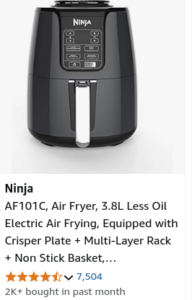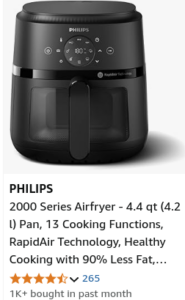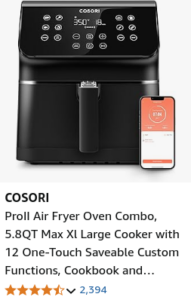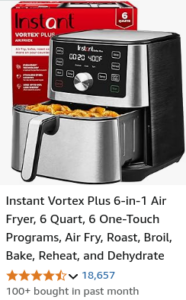The ability of the air fryer to produce tasty, crispy food with minimal oil has made it one of the most popular kitchen gadgets in recent years. It’s a game-changer for those looking to enjoy their favorite fried foods while maintaining a healthier lifestyle. Below, we dive into the essentials of air fryer healthy cooking, exploring how to make the most out of your air fryer and tips for creating healthier meals.
Understanding How an Air Fryer Works
An air fryer is a practical kitchen tool that employs hot air circulation to cook food, simulating the effects of deep frying without requiring a lot of oil. This cooking method makes it possible to enjoy crispy, golden food while significantly reducing fat content. Here’s a breakdown of how an air fryer works:
- Hot air circulation: By rapidly circulating hot air over the food, the air fryer fries the outside while maintaining a soft and moist within.
- Minimal oil use: Unlike traditional frying methods, an air fryer requires very little or no oil, making it a healthier option for cooking. A light spray or brush of oil is often enough to achieve a crispy finish.
- Healthier cooking method: Air-frying lowers the total fat level of your meals by using less oil, which helps you stick to a lower calorie diet without compromising flavor.
- Even cooking: The hot air circulates evenly, ensuring that food cooks uniformly from all sides, creating a consistent texture without the need for flipping or turning.
- Faster cooking: Air fryers are a practical choice for quick, healthful meals because they often cook food faster than traditional ovens.
Choosing Healthier Ingredients
Choosing the correct ingredients is essential when cooking nutritious meals in an air fryer. By opting for fresh, whole foods, you can create balanced and nutritious meals that are lower in fat and calories. Here are some key ingredients to consider for healthier air fryer meals:
- Lean Proteins: Pick fish, chicken breasts, or plant-based substitutes like tofu and tempeh. These choices help maintain lean and satisfying meals since they are high in protein and low in fat.
- Vegetables: Air-frying is a fantastic way to enjoy vegetables like Brussels sprouts, cauliflower, and carrots without added fat. Vegetables naturally become tender and crispy in the air fryer, making them an ideal option for a nutritious side dish or snack.
- Whole Grains: For extra nutrition, add whole grains, such as brown rice or quinoa, to your air-fried meals. The substantial fiber content of whole grains supports intestinal health and prolongs feelings of fullness.
Reducing Oil Use
One of the standout benefits of using an air fryer is its ability to create crispy, flavorful food with little to no oil. This technique greatly reduces calories and bad fats while still giving you the texture you want. Here are some key tips for reducing oil use when cooking with an air fryer:
- Use healthier oils: Choose oils like olive oil, avocado oil, or coconut oil. Heart health benefits from the abundance of heart-healthy lipids found in these oils. They provide flavor and texture without the need for excessive amounts of oil.
- Spray instead of pour: Instead of pouring the food straight into the basket, lightly mist it with oil. This helps control the amount of oil used, preventing excess fat and calories while still ensuring a crispy finish.
- Oil spray bottle: Use an oil spray bottle to control oil application. This gives you more precise control over the oil distribution, allowing you to use only a small amount to achieve the best results.
Air Fryer Healthy Cooking Techniques
When using an air fryer, there are several techniques you can implement to make your meals even healthier. By opting for lighter alternatives and focusing on whole ingredients, you can enjoy all the crispy goodness without sacrificing nutrition. Here are some healthier cooking techniques to try:
- Breaded and Coated Foods: Instead of using heavy breadcrumbs or batter, opt for lighter coatings like whole wheat breadcrumbs, panko, or even ground flaxseeds. These substitutes still have a crunchy quality but have less fat and calories. For an added crunch, try crushed nuts like almonds or pistachios.
- Roasting and Grilling: The air fryer excels at roasting vegetables and grilling lean meats. Use herbs, spices, and a pinch of salt to enhance flavor without adding extra calories. This method preserves the food’s nutritional value while enhancing its inherent flavors.
- Avoid Pre-packaged Foods: Many pre-packaged frozen foods, such as fries and nuggets, are high in unhealthy fats, sodium, and preservatives. Instead, make your own healthier versions using fresh, whole ingredients to control the amount of oil, salt, and additives in your meals.
- Try Baking: Air fryers can also be used to bake healthier options, such as whole grain muffins or low-fat brownies. Without compromising flavor, you can make your baked products healthy by using whole grain flour and natural sweeteners like stevia or honey.
- Use Air Fryer “Crusts”: Instead of using deep-fried or heavy breading, make a lighter “crust” by using grated vegetables like cauliflower or zucchini as a base. These vegetable crusts are lower in carbs and provide added nutrients.
- Steam or Poach: Some air fryers come with a steaming function. This can be used for cooking fish, poultry, or even dumplings with minimal oil, keeping the dishes light and full of moisture.
Air Fryer Healthy Cooking Guides & Cookbooks
- Air Fryer Cookbook: 1000 Day Delicious, Quick & Easy Air Fryer Recipes for Everyone
- Air Fryer Cheat Sheet Magnets Cooking Guide Cookbook
- The Complete Air Fryer Cookbook for Beginners: Healthy and Super-Easy Everyday Air Fryer Recipes
- Air Fryer Cookbook: 600 Effortless Air Fryer Recipes for Beginners and Advanced Users
- The Healthy Air Fryer Cookbook: Truly Healthy Fried Food Recipes with Low Salt, Low Fat, and Zero Guilt
- The Skinnytaste Air Fryer Cookbook: The 75 Best Healthy Recipes for Your Air Fryer
- Easy Air Fryer Recipe Book: Best Airfryer Cookbook Recipes for Beginners to Advanced
- 20 Minute Healthy Air Fryer Cookbook for Two: Healthy Dinners, Indulgence Desserts, Sugar-Free and Diabetic-Friendly
Essential Air Fryer Recipes for Healthy Eating
An excellent tool for producing flavorful, nutritious, and quick meals is the air fryer. It’s simple to make meals that are lower in fat and calories than typical frying techniques, whether you’re creating snacks, sides, or even main courses. Here’s a simple, healthy air fryer recipe to get you started:
Air-Fried Veggie Chips
Set your air fryer’s temperature to 375°F to get started. As it heats up, finely slice the zucchini and toss it in a mixture of salt, pepper, and olive oil until it is equally coated. To guarantee consistent cooking, place the slices of zucchini in a single layer in the fryer basket. To guarantee that the zucchini chips are crispy on all sides, shake the basket halfway during the cooking process. After the air fryer has heated up, put the basket inside and cook for 12 to 15 minutes. Enjoy a light, crunchy snack or a healthy side dish with minimal oil!
Air-Fried Chicken Breast
Set your air fryer’s temperature to 375°F to begin. Season with salt, pepper, paprika, and garlic powder and massage the chicken breasts with olive oil while it’s heating up. Make sure the seasoning coats the chicken evenly. Once the air fryer is preheated, place the seasoned chicken breasts in the basket, making sure they are arranged in a single layer. To make sure the chicken cooks evenly, flip it halfway through the 18 to 20 minutes of cooking. The result will be tender, juicy chicken on the inside with a crispy, golden exterior, making it a perfect healthy meal.
Air-Fried Sweet Potato Fries
Set your air fryer’s temperature to 400°F to start. As it heats up, chop the sweet potatoes into fries and cover them thoroughly using a blend of paprika, salt, pepper, and olive oil. To ensure equal cooking, place the sweet potato fries in the basket of the air fryer in a single layer when it is ready. To guarantee the fries cook uniformly and are crispy on all sides, shake the basket halfway during the 15 to 20 minutes of air fry time. These air-fried sweet potato fries will be tender on the inside and crispy on the outside, making for a delicious and healthier side dish.
Air-Fried Brussels Sprouts
Set the air fryer’s temperature to 375°F to begin. Snip off the tip of the Brussels sprouts as well as slice them in half. Add salt, pepper, olive oil, and a little balsamic vinegar for taste. Put the Brussels sprouts in the basket in a single layer after the air fryer has heated up. To guarantee they cook evenly, shake the basket midway through the 15–18 minute cooking time. The Brussels sprouts will be crispy on the outside and tender on the inside, making for a nutritious and satisfying side dish.
Air-Fried Salmon
Set your air fryer’s temperature to 400°F. Add salt, pepper, garlic powder, lemon juice, and olive oil to the salmon fillets. Once the air fryer is heated, place the salmon fillets in the basket skin-side down. The salmon should be cooked through and flake readily with a fork after 10 to 12 minutes of cooking. The result will be a perfectly cooked, moist, and flavorful salmon with a slightly crispy crust. This makes for a great lean protein option for a quick and healthy meal.
Air Fryer Tips for Success
Air fryers are a great tool for preparing healthy, crispy dishes with minimal oil. However, achieving the best results requires some attention to detail and a few helpful tricks. Your food prepared in an air fryer will always turn out flawlessly if you follow these tips:
- Don’t Overcrowd: Air fryers work best when there’s ample space for air to circulate around the food. The meal may cook unevenly if the basket is overcrowded, leaving some areas mushy or undercooked. For optimal results, cook in batches if necessary.
- Preheat the Air Fryer: The food will crisp up more evenly if the air fryer is preheated for a few minutes before cooking. It ensures the right cooking temperature right from the start, so your meals turn out just the way you want them.
- Shake or Flip: To guarantee even cooking and crispiness, turn your meal over halfway through the cooking time or shake the basket. For the ideal texture, this helps guarantee that the food is exposed to the hot air on all sides.
- Experiment with Herbs and Spices: Air frying is a great opportunity to experiment with a variety of herbs and spices. Use rosemary, thyme, and oregano for savory dishes or cumin, turmeric, and chili powder for a bolder flavor. This enhances the taste without adding unnecessary calories.
- Use a Light Coating of Oil: A light mist or spray of oil can help enhance the crispiness of your air-fried foods. Be sure to use an oil spray bottle or a minimal amount of oil to keep your meals healthy and flavorful.
- Monitor Cooking Time: Because air fryers can cook food quickly, pay attention to the cooking time. Checking in towards the end of the recommended cooking time ensures that your meal doesn’t overcook or burn, keeping it juicy and tender.
The Health Advantages of Air Fryer Healthy Cooking
When it comes to cooking healthy meals without compromising flavor, using an air fryer can be revolutionary. Air frying has many health advantages that make it a fantastic option for anyone trying to eat healthily because it eliminates the need for extra oil. Here are some of the key health benefits of cooking with an air fryer:
- Lower Fat Content: Air frying significantly reduces the amount of fat in your meals compared to traditional deep frying. By using hot air circulation instead of submerging food in oil, you can achieve that crispy texture while keeping the fat content much lower, making it a healthier option.
- Reduced Calories: Since less oil is used in the cooking process, air-fried foods tend to have fewer calories overall. This makes them an excellent choice for those on a calorie-controlled diet, helping you enjoy your favorite dishes without the added calories of deep frying.
- Preserved Nutrients: Air frying helps to preserve the nutrients in vegetables and other foods, as the quick cooking method retains vitamins and minerals better than boiling or deep frying in oil. This means your meals are not only healthier in terms of fat and calories, but they also maintain their nutritional value.
- Less Toxic Compounds: Conventional frying can result in the production of toxic substances like acrylamide, which is produced when high temperatures are applied to starchy foods. Air frying reduces the risk of these compounds forming, making your meals safer and healthier.
- Improved Digestibility: Air frying helps maintain the integrity of the food’s natural fibers, which can aid in digestion. The crispiness created in the air fryer can also make vegetables and other healthy foods more palatable, encouraging you to eat more nutritious meals.
Choosing the Right Air Fryer for Your Needs
When it comes to selecting the right air fryer, factors like price, capacity, features, and customer ratings can help guide your decision. To make it easier for you, here’s a table comparing some of the best air fryers on the market, based on these key factors.
| Model | Capacity | Features | Price Range |
| Ninja AF101 Air Fryer | 4 quarts | 4-in-1 cooking functions (air fry, roast, bake, reheat), easy-to-clean basket
Also check out The Complete Ninja Foodi 2-Basket Air Fryer Cookbook |
$99.99 – $119.99 |
| Philips 2000 Series | 4.4 quarts | 13 Cooking Functions, Rapid Air technology, cooking window, easy cleanup | $179.99 – $199.99 |
| Cosori Smart Air Fryer | 5.8 quarts | Wi-Fi enabled, preset cooking options, non-stick basket | $129.99 – $149.99 |
| Instant Vortex Plus | 6 quarts | 7-in-1 cooking, smart cooking presets, easy to clean | $89.99 – $109.99 |
Conclusion
A multipurpose kitchen tool, the air fryer makes it simple to cook healthy, crispy dishes with less oil. By understanding how it works and implementing smart cooking techniques, you can significantly reduce fat, calories, and harmful compounds in your food, all while preserving essential nutrients.
Key Takeaways:
- Healthier Meals: Air frying is an outstanding choice for people trying to keep or reduce weight because it allows you to enjoy your favorite fried meals with less fat and calories.
- Smart Ingredient Choices: Choose fresh, healthy meals like veggies, lean meats, and whole grains to optimize the health advantages. These can be air-fried to perfection without the need for excess oil.
- Cooking Tips: To improve the taste of your food without adding extra calories, follow these crucial guidelines: warm your air fryer, avoid packing the basket too full, and experiment with different herbs and spices.
- Air Fryer Benefits: Aside from reducing fat and calories, air frying also helps preserve nutrients in your food, making it a healthier cooking method overall.
- Choosing the Right Model: Whether you’re on a budget or seeking advanced features, there’s an air fryer to meet your needs. Refer to the comparison table to find one that fits your preferences and cooking style.
Frequently Asked Questions (FAQs) about Cooking with an Air Fryer
Is cooking with an air fryer really healthier than deep frying?
Yes! Because air fryers use little to no oil, they considerably reduce the fat and calorie content of your meals, making them much healthier than deep-frying. The air fryer uses hot air circulation to cook food, creating a crispy texture without the need for excessive oil, unlike traditional deep frying.
Can I use an air fryer to cook vegetables?
Absolutely! Air fryers are fantastic for cooking vegetables. You can easily air-fry vegetables like zucchini, broccoli, Brussels sprouts, and sweet potatoes with just a light spray of oil to make them crispy and delicious. Air frying helps preserve the nutrients in vegetables while giving them a wonderful texture.
How do I prevent my food from being soggy in the air fryer?
To avoid soggy food, make sure to avoid overcrowding the basket, as this can hinder air circulation. Additionally, ensure that the food is coated with a small amount of oil, either by spraying or tossing it lightly. A uniformly crisp finish can also be obtained by shaking or turning the meal midway through the cooking process.
Is it possible to prepare desserts in an air fryer?
You may produce a range of desserts using an air fryer, such as brownies, fruit crisps, or air-fried donuts, in addition to savory foods. The air fryer can bake desserts with a crispy outside and tender inside, offering a healthier alternative to traditional deep-frying methods.
How do I choose the right air fryer for my needs?
Think about things like pricing, features, capacity, and user reviews when selecting an air fryer. A type with a lesser size (2-4 quarts) can be adequate for single people or small families. A model with a 5+ quart capacity can be more advantageous for larger families. Refer to our air fryer comparison table for more detailed recommendations.




